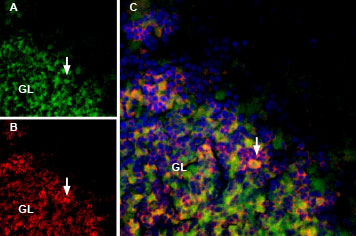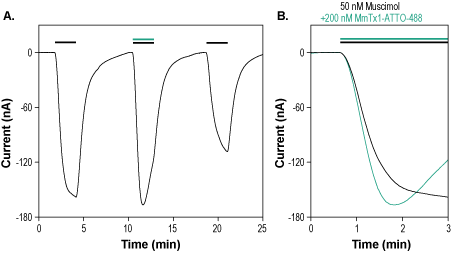Overview
- Rosso, J.P. et al. (2015) Proc. Natl. Acad. Sci. U.S.A. 112, E891.
Centrifuge the vial before adding solvent (10,000 x g for 5 minutes). The lyophilizate may be difficult to visualize. Add solvent directly to the centrifuged vial. Tap the vial to aid in dissolving the lyophilized product. Tilt and gently roll the liquid over the walls of the vial. Avoid vigorous vortexing. Light vortexing for up to 3 seconds is acceptable if needed.
Soluble in pure water at high-micromolar concentrations (50 µM - 1 mM). For long-term storage in solution, it is recommended to prepare a stock solution by dissolving the product in double distilled water (ddH2O) at a concentration between 100-1000x of the final working concentration. Divide the stock solution into small aliquots and store at -20°C. Before use, thaw the relevant vial(s) and dilute to the desired working concentration in your working buffer. Centrifuge all product preparations at 10,000 x g for 5 minutes before use. It is recommended to prepare fresh solutions in working buffers just before use. Avoid multiple freeze-thaw cycles to maintain biological activity. Avoid exposure to light.
 Alomone Labs MmTx1 Toxin-ATTO Fluor-488 labels GABA(A) α1 receptor in rat cerebellum.Rat brain sections were incubated with MmTx1 Toxin-ATTO Fluor-488 (#STM-550-AG) at a concentration of 25 nM. The sections were then incubated with Anti-GABA(A) α1 Receptor (extracellular) Antibody (#AGA-001), followed by donkey anti rabbit labeled with Cy3 (red). A. MmTx1 Toxin-ATTO Fluor-488 binding (green) appears in patches within the granule layer (GL), (arrows). B. GABA(A) α1 receptor immunostaining appears in profiles of GL neurons (arrow). C. Merge of the two images demonstrates variable colocalization. DAPI is used as the counterstain.
Alomone Labs MmTx1 Toxin-ATTO Fluor-488 labels GABA(A) α1 receptor in rat cerebellum.Rat brain sections were incubated with MmTx1 Toxin-ATTO Fluor-488 (#STM-550-AG) at a concentration of 25 nM. The sections were then incubated with Anti-GABA(A) α1 Receptor (extracellular) Antibody (#AGA-001), followed by donkey anti rabbit labeled with Cy3 (red). A. MmTx1 Toxin-ATTO Fluor-488 binding (green) appears in patches within the granule layer (GL), (arrows). B. GABA(A) α1 receptor immunostaining appears in profiles of GL neurons (arrow). C. Merge of the two images demonstrates variable colocalization. DAPI is used as the counterstain. Live cell imaging of MmTx1 Toxin-ATTO Fluor-488 in intact human HEK-293T cells expressing GABRB3. HEK-293T cells were transfected with GABRB3 plasmid for 72 hours. (A) HEK-293T GABRB3 underwent incubation with 2 µM of MmTx1 Toxin-ATTO Fluor-488 for 60 minutes at 37ºC, followed by PBSX1 wash, leading to green fluorescence indicative of the distribution of GABA(A)β3 receptor. (B) Incubation of HEK-293T (non-transfected, control cells) with 2 µM of MmTx1 Toxin-ATTO Fluor-488 shows no toxin staining. Membranal staining of cells appears in orange.
Live cell imaging of MmTx1 Toxin-ATTO Fluor-488 in intact human HEK-293T cells expressing GABRB3. HEK-293T cells were transfected with GABRB3 plasmid for 72 hours. (A) HEK-293T GABRB3 underwent incubation with 2 µM of MmTx1 Toxin-ATTO Fluor-488 for 60 minutes at 37ºC, followed by PBSX1 wash, leading to green fluorescence indicative of the distribution of GABA(A)β3 receptor. (B) Incubation of HEK-293T (non-transfected, control cells) with 2 µM of MmTx1 Toxin-ATTO Fluor-488 shows no toxin staining. Membranal staining of cells appears in orange. Direct flow cytometry of MmTx1 in live intact human HEK-293T cells expressing GABRB3.___ HEK-293T GABRB3 cells.
Direct flow cytometry of MmTx1 in live intact human HEK-293T cells expressing GABRB3.___ HEK-293T GABRB3 cells.
___ HEK-293T GABRB3 cells + 2 µM MmTx1 (#STM-550).
___ HEK-293T GABRB3 cells + 2 µM MmTx1-ATTO Fluor-488 (#STM-550-AG). Alomone Labs MmTx1 Toxin-ATTO Fluor-488 modulates GABA(A) receptors expressed in Xenopus oocytes.A. Representative time course of GABA(A) α1/β2 current activated at a holding potential of -60 mV by 50 nM Muscimol hydrobromide (#M-240) application (black bars), and modulated by co-application of 200 nM MmTx1 Toxin-ATTO Fluor-488 (#STM-550-AG), as indicated (green bar). A significant modulation of receptor desensitization and reactivation rate are observed. B. Superimposed traces of GABA(A) currents upon application of 50 nM Muscimol hydrobromide (black) or co-application of 50 nM Muscimol and 200 nM MmTx1Toxin-ATTO Fluor-488 (green). Taken from the recording in A.
Alomone Labs MmTx1 Toxin-ATTO Fluor-488 modulates GABA(A) receptors expressed in Xenopus oocytes.A. Representative time course of GABA(A) α1/β2 current activated at a holding potential of -60 mV by 50 nM Muscimol hydrobromide (#M-240) application (black bars), and modulated by co-application of 200 nM MmTx1 Toxin-ATTO Fluor-488 (#STM-550-AG), as indicated (green bar). A significant modulation of receptor desensitization and reactivation rate are observed. B. Superimposed traces of GABA(A) currents upon application of 50 nM Muscimol hydrobromide (black) or co-application of 50 nM Muscimol and 200 nM MmTx1Toxin-ATTO Fluor-488 (green). Taken from the recording in A. Alomone Labs MmTx1 Toxin-ATTO Fluor-488 modulates GABA(A) receptors expressed in Xenopus oocytes.A. Representative time course of GABA(A) α1/β2 current activated at a holding potential of -80 mV by 50 nM Muscimol hydrobromide (#M-240) application (black bars), and modulated by co-application of 400 nM MmTx1 Toxin-ATTO Fluor-488 (#STM-550-AG), as indicated (green bar). A significant modulation of receptor desensitization and reactivation rate are observed. B. Superimposed traces of GABA(A) currents upon application of 50 nM Muscimol hydrobromide (black) or co-application of 50 nM Muscimol and 400 nM MmTx1 Toxin-ATTO Fluor-488 (green). Taken from the recording in A.
Alomone Labs MmTx1 Toxin-ATTO Fluor-488 modulates GABA(A) receptors expressed in Xenopus oocytes.A. Representative time course of GABA(A) α1/β2 current activated at a holding potential of -80 mV by 50 nM Muscimol hydrobromide (#M-240) application (black bars), and modulated by co-application of 400 nM MmTx1 Toxin-ATTO Fluor-488 (#STM-550-AG), as indicated (green bar). A significant modulation of receptor desensitization and reactivation rate are observed. B. Superimposed traces of GABA(A) currents upon application of 50 nM Muscimol hydrobromide (black) or co-application of 50 nM Muscimol and 400 nM MmTx1 Toxin-ATTO Fluor-488 (green). Taken from the recording in A.
- Rosso, J.P. et al. (2015) Proc. Natl. Acad. Sci. U.S.A. 112, E891.
- Middendorp, S.J. et al. (2015) Neuropharmacology 95, 459.
MmTx1 (Micrurotoxin 1) is a peptide toxin originally isolated from Micrurus mipartitus (Red-tailed coral snake) venom. The toxin is an allosteric modulator of γ-aminobutyric acid type A receptors (GABA(A)) and tightly binds to GABA(A) receptors at subnanomolar concentrations. MmTx1 allosterically increases GABA(A) receptor susceptibility to agonistic actions, thereby potentiating receptor opening and desensitization by interacting with the α+/β−interface, a benzodiazepine-like binding site1. MmTx1 may be a priceless tool in evoking seizures for testing novel antiepileptic drugs or as lead molecules for designing therapeutics that modulate GABA(A) receptor activity1.
GABA(A) receptors belong to the cys-loop pentameric ligand-gated ion channel family. These receptors are major inhibitory neurotransmitter receptors in the brain and in the mammalian central nervous system and are responsible for the mediation of GABA action, a major inhibitory neurotransmitter, through the central nervous system2.
MmTx1 Toxin-ATTO Fluor-488 (#STM-550-AG) is a highly pure, synthetic, and biologically active conjugated peptide toxin.
✓ Localization and distribution
✓ Live cell imaging
✓ Single cell detection
✓ Direct flow cytometry
We gladly take on collaboration projects. Please Contact Us.

